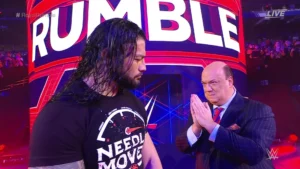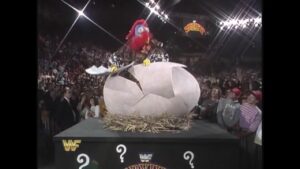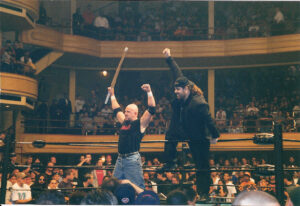In the first installment of this series discussing wrestling video games, the major players on the Nintendo Entertainment System were covered. There were a few that stood out, but this genre would build considerable momentum in the console generation that followed. As time went on, the technology of the NES was growing limited. As a result, it made sense for not only Nintendo but other companies to produce consoles that boasted better graphics, sound, and overall performance. Along with the consoles in question came a slew of wrestling video games.
The 16-Bit Generation
Among the competitors Nintendo faced, especially in the 90s, Sega stood head and shoulders above the rest. The latter company released its own platforms in the past. It was the Genesis, however, that made it a household name. The Sega Genesis, as it was known in the states, was released in Japan in 1988. From there, it was released in North America in 1989 and other locations in 1990. Boasting such titles as the “Shinobi III,” “Gunstar Heroes,” and the “Sonic the Hedgehog” series, the 16-bit Genesis proved more than formidable against the 8-bit NES.
Times were changing, as Nintendo noticed, which prompted the release of their own 16-bit platform. The Super Nintendo Entertainment System was released in Japan in 1990; other regions received it in the years that followed. New additions to beloved series, not to mention brand-new series such as “Donkey Kong Country” and “Mario Kart” helped make the SNES a bonafide classic. Additionally, the SNES featured enhancement chips, which made graphically impressive titles, for the time, including “Star Fox” possible.
To this day, gamers debate over the better system: was it the SNES or Genesis? The answer largely comes down to preference, but regardless of where one stood, a number of solid titles were enjoyed. Needless to say, wrestling video games were among the vast titles included. Here are the standouts that should be revisited or experienced for the first time.

WWF RAW
During the 16-bit era, many of the World Wrestling Federation-branded wrestling video games were published by LJN. The company in question was known for distributing a litany of licensed games, some better than others. Of course, professional wrestling wasn’t left out. Many of their Genesis and NES wrestling games were built with the same engine. These were evidenced by “WWF Super WrestleMania” and “WWF Royal Rumble.” However, it would be “WWF RAW,” released in 1994, that proved to be the most refined of the bunch.
The best term that can be used to describe “WWF RAW” and its ilk would be “button-masher.” Whenever two wrestlers lock up, the player would have to repeatedly tap buttons to either perform a move or whip their opponent into the ropes. As an opponent’s health depletes, the player can execute a finishing move. Its predecessors followed the same format, but they were comparatively slower to “WWF RAW,” which kept the action going at a steady clip.
Both the Genesis and SNES versions play identically, though there are a few differences to note. The sound is most prominent; whereas the Genesis has audio that can best be described as “grungy,” the SNES was more robust. Additionally, since the standard Genesis controller had fewer buttons, its version of “WWF RAW” can be more of a challenge. Regardless, this game is worth trying on either platform.

WWF WrestleMania: The Arcade Game
Outside of LJN, the World Wrestling Federation partnered with other developers and publishers. Enter Midway, which gained fame in the 90s largely due to its ultraviolent “Mortal Kombat” series. The WWF worked with Midway to release the aforementioned arcade game. However, it wouldn’t remain in bowling alleys, shopping malls, and the like for long. Like many popular arcade titles, “WWF WrestleMania: The Arcade Game” would make its way to consoles, including the SNES and Genesis.
“WWF WrestleMania: The Arcade Game,” released in the mid-90s, features a presentation that’s realistic and over-the-top. For example, a wrestler can perform a move as simple as a kick, only for their opponent to leap into the air and crash like a cartoon character. Special moves involve the use of zany elements, such as The Undertaker utilizing a tombstone as a weapon and Bam Bam Bigelow attacking with fiery fists ala The Human Torch. This game takes creative liberties, which is what many gamers fondly remember it for.
It’s important to note that “WWF WrestleMania: The Arcade Game” has a small roster. While the Genesis version features the 8 wrestlers from the original arcade release, the SNES has 6, omitting Bigelow and Yokozuna. Furthermore, there are two single-player modes: one where the player vies for the Intercontinental Championship and the other where they fight for the WWF Championship. Despite these shortcomings, “WWF WrestleMania: The Arcade Game” is worth trying. If nothing else, seeing the kooky attacks is worth a chuckle.

Super Fire Pro Wrestling Special
Unbeknownst to gamers in America, there existed another series of wrestling video games. It was, at the time, exclusive to Japan. “Fire Pro Wrestling,” which was started by Human Entertainment, featured an in-depth grappling system, timing-based maneuvers, and a robust editing feature that allowed players to create their own wrestlers. There were several “FPW” games on the Super Famicom (the Japanese name for the SNES). These included “Super Fire Pro Wrestling: Queen’s Special,” which was based on All Japan Women’s Pro Wrestling.
The focus of this piece is what many view as the most controversial entry of all. “Super Fire Pro Wrestling Special,” released in December of 1994 in Japan, featured the same involved gameplay the “FPW” series was known for. However, its claim to fame was its story mode. Players take on the role of a young rookie in wrestling, who rises through the ranks, all the while experiencing heartbreak and grief. Without going into spoilers, this campaign is both compelling and not for the faint of heart.
“Fire Pro Wrestling” remained a Japan-only series for years to come and wouldn’t see an American release until 2001. Regardless, this series is highly regarded by fans and for good reason. In fact, any one of the 16-bit entries can be selected and it would be a solid choice. However, for those that are looking for unique, not to mention gut-wrenching, fare in the sea of wrestling video games, “Super Fire Pro Wrestling Special” may be for you.
https://youtu.be/f4d-A3TOle8
Saturday Night Slam Masters
Nintendo and Sega were the two heavy hitters of the 16-bit era. That said, there were companies that focused solely on game development and publishing. Enter “Saturday Night Slam Masters,” released by Capcom in 1993. It was an arcade game that was ported to home consoles. During the 80s and 90s, Capcom was one of the most prolific companies in the video game scene. “Mega Man” and “Street Fighter” were just a few of their big hits, but they dabbled in off-shoot titles, “Saturday Night Slam Masters” being a prime example.
“Saturday Night Slam Masters” is one of the most unique entries in wrestling video games, as it plays more like a beat-em-up ala “Final Fight,” another Capcom series. In fact, one of the characters from the latter series, Mike Haggar, is a playable character here. The game is fairly easy to pick up and play, as one button is each dedicated to attacking, jumping, and pinning. To learn more maneuvers, including the devastating finisher known as the Super Slam Technique, practice will be required.
In terms of 16-bit wrestling games that only saw the light of day in America, “Saturday Night Slam Master” is the best aged.
From its easy to learn, difficult to master controls, its hard-hitting action, and its colorful presentation, this is a console port of an arcade game done right. Furthermore, it was released on both the SNES and Genesis, meaning no one will be left out. There are differences between the two versions; the SNES version features a Team Battle Royale while the Genesis version offers a Death Match in its place. Otherwise, an indistinguishable experience will be shared.
The 16-bit generation of gaming is fondly remembered and understandably so. It saw the release of several games that are still considered classics. It also helped grow the popularity of wrestling video games, ensuring that they see consistent releases on platforms that followed. During the mid-to-late 90s, the generation in question began to wind down as 3D graphics started to become the norm. Next time, we will take a look at wrestling video games released on the original PlayStation.
Check out past entries from the “Revisiting Wrestling Video Games” series!
Stay tuned to the Last Word on Pro Wrestling for more on this and other stories from around the world of wrestling, as they develop. You can always count on LWOPW to be on top of the major news in the wrestling world, as well as to provide you with analysis, previews, videos, interviews, and editorials on the wrestling world.






